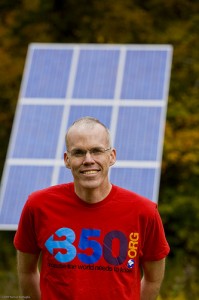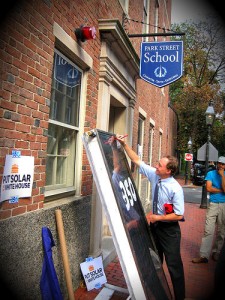The Union of Concerned Scientists, a national non-profit of citizens and scientists for environmental solutions based in Harvard Square, have cleanly outlined several concrete actions for you to take to meet those ends. They have taken to the road, holding meetings focused on spreading the knowledge and skills to effectively use your constituency as leverage. Although yesterday the Senate majority leader Harry Reid announced that they will not look at climate legislation until September, others are firmly professing that all hope is not lost.
“This is not going to die, absolutely rest assured this is not going away,” Kerry told visitors to Congress.
“As long as I am in the Senate and I’ve got another four years … we are going to keep pounding away on this.”
The goal that the UCS promotes for the upcoming legislation fight is to inform our on-the-fence Senators (e.g. Senator Scott Brown) what their voters want — comprehensive clean energy and climate legislation, and the green jobs, health benefits, and world status that will come with it.
The methods discussed were as follows:
Letters to the Editor
Follow local newspapers, and when there is an article written that has anything to do with this topic, respond to it. Letters to the editor are a good way to reach a wide, local audience. Another perk to these is that Senators have their staff tracking editorials mentioning them, so their attention will be brought to these articles if you mention them. If you aren’t published, your article will still be one more on the topic that tells the editor what the readership is thinking about. Some tips: name a Senator, keep it brief (150 and 200 words) so that your arguments are less likely to be edited, make it personal (refer to your expertise if you have some), add a call to action or timeframe (e.g. Legislation, this summer!). If your article is printed, send it into the Senator’s office via email or online form, because snail mail will be delayed due to biohazard processing in D.C.
Phone calls to Senators
For Cambridge and all of Massachusetts, it is important to call Senator Scott Brown’s offices both in Washington D.C. (202-224-4543 – Staffer Nat Hoopes) and Boston (617-565-3170) to let his staff know that you, as a constituent, want a comprehensive climate and energy bill as soon as possible. Because the Senator is concerned about cost and jobs, these may be good points do to your homework on before calling.
We may also call Senator John Kerry, to let him know that we appreciate his championing Climate legislation in the past and are grateful for his continuation of that act.
Meetings with Legislators/their staff
You have a right to this as well. These are good places to bring in evidence that you have found to support your wishes, as well as to bring in experts you know, or others who are on your side that the Senator might relate to. If you ask a question, be sure to ask when you can follow up to get an answer, and be sure to do the same if you are asked to find out some information.
Online Networking
Senator Brown has a Facebook page, and presently is being berated by unhappy constituents; a civilly toned note might be taken quite significantly in such a climate. You can also pass word along about this topic to your friends via email as well as Facebook, Twitter, Myspace, or any other online vessel you might use.
It’s agreed that the drafts of bills presented so far are not perfect, and that whatever legislation is ultimately presented will likely also be imperfect. It may seem foolish to some, to seemingly throw caution to the wind and press for passage of any old climate/clean energy legislation that’s up for grabs. The discussed sentiment is that if this legislation is passed—if ANY climate/clean energy legislation is passed—it will act as a firm shoe in the door, allowing for the breeze of forward-thinking climate action to roll in a little bit more smoothly. The imperfection of whatever bill is passed is only an obstacle in that it takes time for amendments to be drafted, voted on, and adopted.




 Under mounting pressure from 10-10-10 groups, 350.org’s Bill McKibben, and various other environmental activists, the Obama Administration
Under mounting pressure from 10-10-10 groups, 350.org’s Bill McKibben, and various other environmental activists, the Obama Administration  Beginning September 7th,
Beginning September 7th, 
 One possible step toward Climate Change mitigation,
One possible step toward Climate Change mitigation, 
![[Men working on telephone lines, probably near a TVA dam hydroelectric plant] (LOC) by The Library of Congress](http://farm3.static.flickr.com/2142/2179061201_9dc6316ae0_m.jpg)